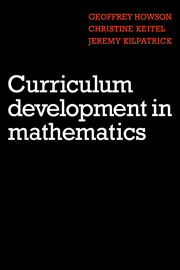Book contents
- Frontmatter
- Contents
- Preface
- 1 Curriculum development: an introduction
- 2 The historical background
- 3 Case studies of curriculum development
- 4 The practice and management of curriculum development
- 5 Curriculum theory and curriculum research
- 6 A retrospective look at curriculum projects
- 7 Evaluation within curriculum development
- 8 Lessons for today and tomorrow
- Appendix 1
- Appendix 2
- Bibliography
- Index
7 - Evaluation within curriculum development
Published online by Cambridge University Press: 05 October 2010
- Frontmatter
- Contents
- Preface
- 1 Curriculum development: an introduction
- 2 The historical background
- 3 Case studies of curriculum development
- 4 The practice and management of curriculum development
- 5 Curriculum theory and curriculum research
- 6 A retrospective look at curriculum projects
- 7 Evaluation within curriculum development
- 8 Lessons for today and tomorrow
- Appendix 1
- Appendix 2
- Bibliography
- Index
Summary
Evaluation is ubiquitous and eternal: people have been judging the worth of their own or others' handiwork since the time of Genesis. In education, every teacher evaluates his teaching in one way or another, if only to help him decide what to do next. Teachers themselves are evaluated by their employers and also by their students, who at least since the time of the medieval university have ‘voted with their feet’ – when they could – to express their satisfaction or dissatisfaction with the instruction they were receiving. But just as the curriculum had not been widely perceived as something to be ‘developed’ until the middle of this century, with the advent of curriculum development projects, so the need for an explicit, formal evaluation of the curriculum did not arise until people began to ask whether the projects had been worthwhile. The job of curriculum evaluator, like the job of curriculum developer, is a twentieth-century invention.
The process of evaluation
What is evaluation? The basic idea is simple: evaluation is the process of judging the value or worth of something. To evaluate, one needs an object, a scale of value, and some means of gathering information about the object so that the scale of value can be applied to the information.
- Type
- Chapter
- Information
- Curriculum Development in Mathematics , pp. 182 - 237Publisher: Cambridge University PressPrint publication year: 1981

